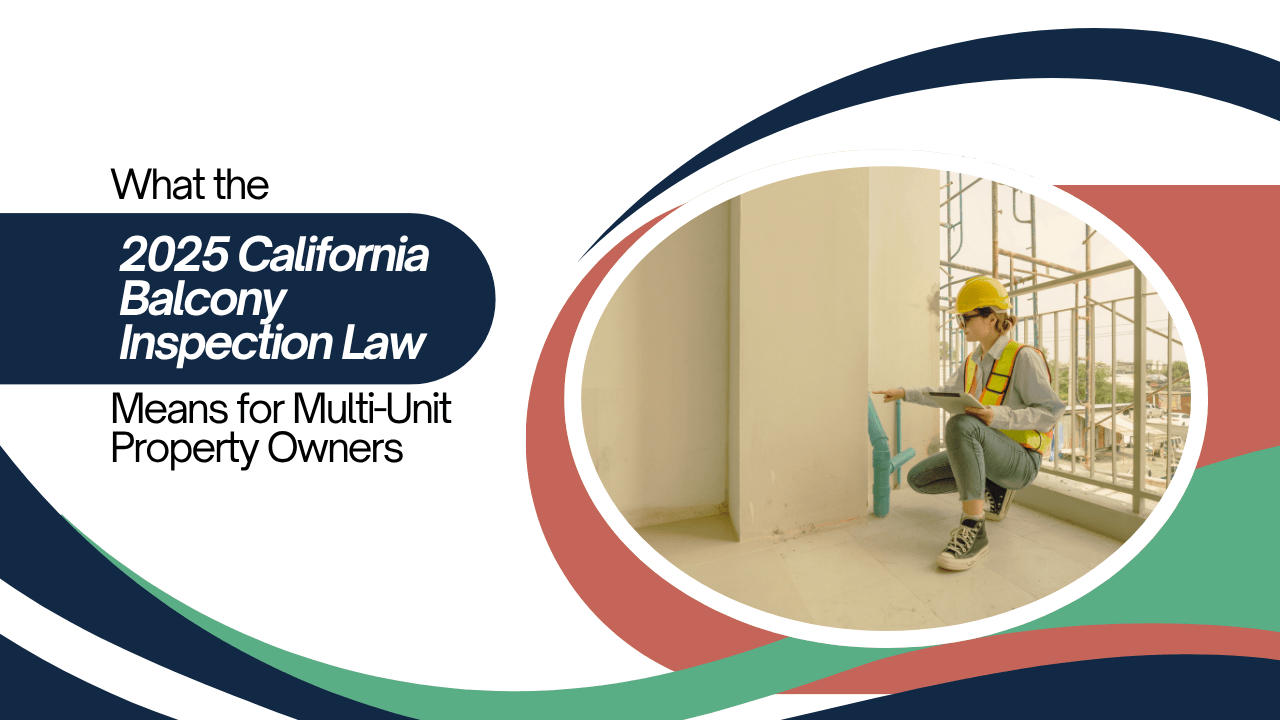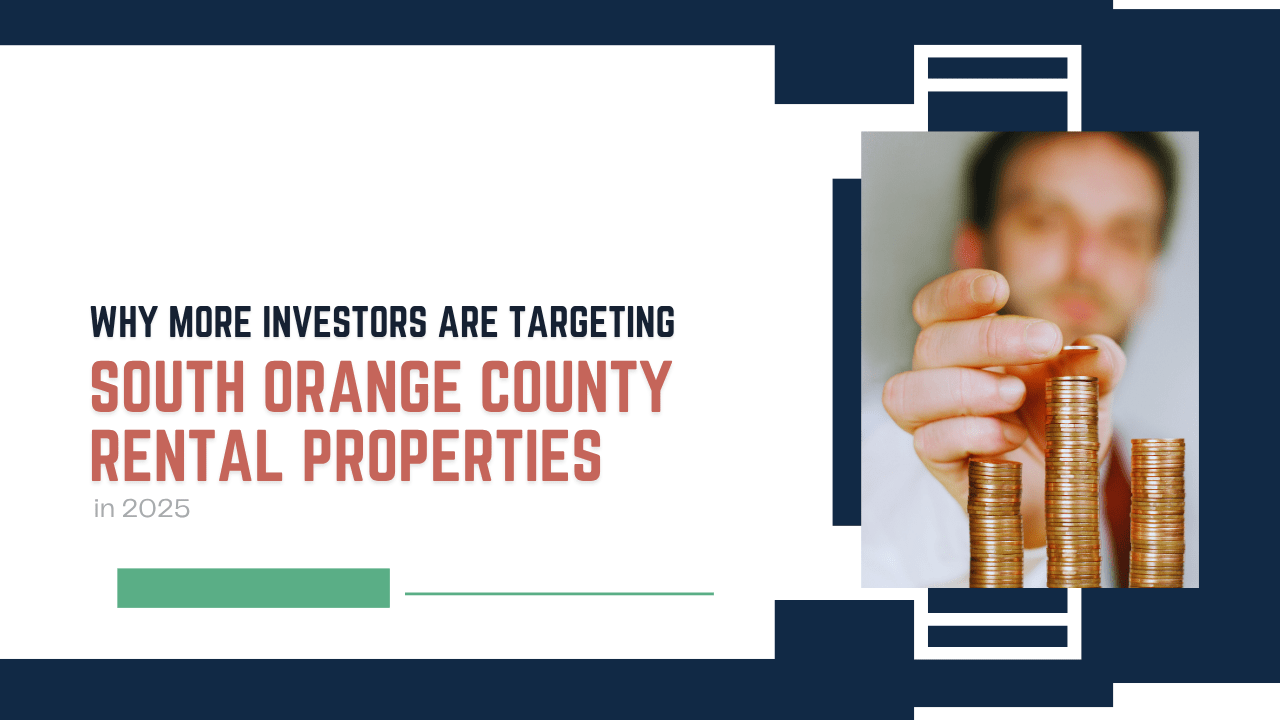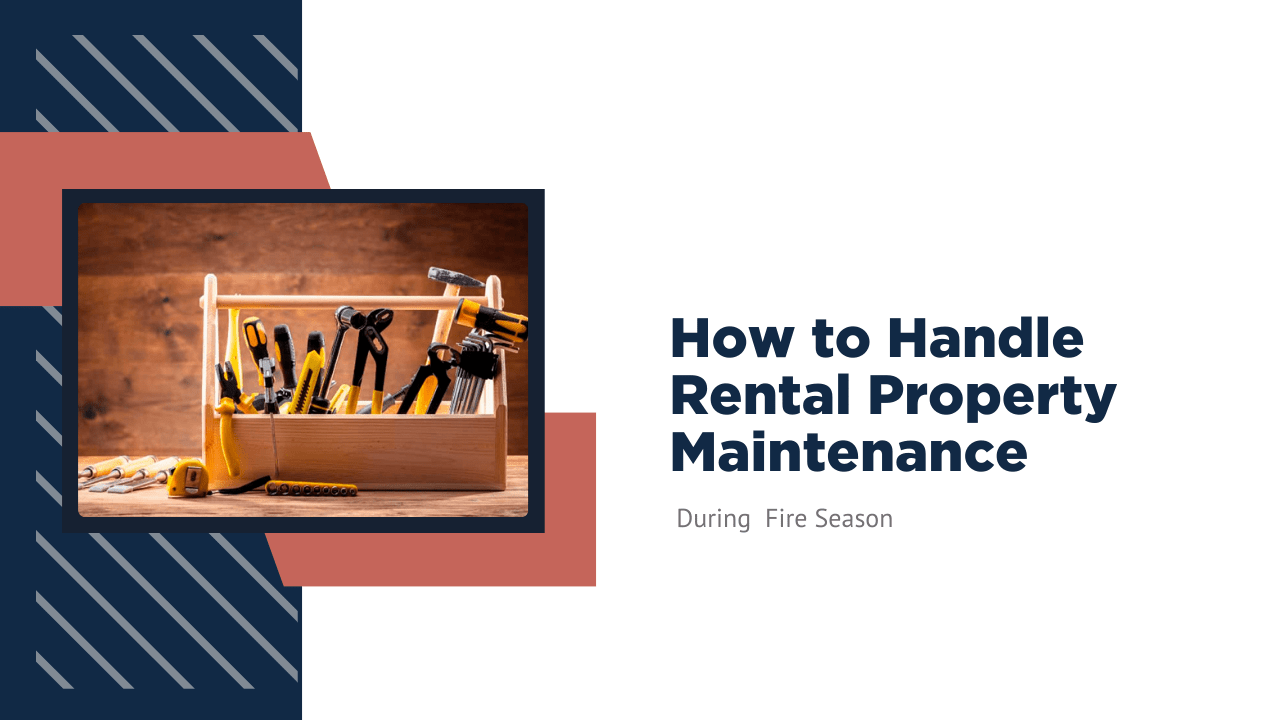Are you prepared to prove that the balcony at your rental properties are safe?
Following the rental laws and legal requirements in California can be a full-time job. Things are always changing. Rules are being enforced and interpreted in new ways. There’s a lot to keep up with, and mistakes are alarmingly easy to make.
That’s why you
work with a property manager. It’s our job to stay up to date and to keep you and your property in compliance.
One thing we have a lot of questions about lately is the new balcony inspection law. Investors are coming to us with questions about what this means for them when they want to buy a multi-unit building that has balconies. Current rental property owners are reaching out for help with their inspections and any work that needs to be done following those inspections.
All of this because California has introduced a sweeping safety mandate for multifamily residential properties. If you’re renting out a multi-family property in California, you’ll need to be aware of the requirements and the deadlines.
It’s hard to argue with legislation that’s designed to protect people. And, the California Balcony Inspection Law, also known as SB 721 and SB 326, is reshaping how landlords approach structural safety.
This law has been coming online for the last several years. After some delays and setbacks, it’s finally ready to be fully enacted and enforced. Now is the time to make sure you’re in compliance.
It’s essential to
understand what this law requires, who it affects, and how to stay compliant.
Balcony Inspection Laws in California
Let’s talk a little bit about how we got here.
The initial balcony inspection laws in California were passed after a 2015 accident in which a Berkeley balcony collapsed, killing six students who had been standing on that balcony, and injuring seven others. The balcony structure sheared right off the building to which it was attached. After several investigations and many lawsuits against the building owner,
property manager, and contractors who had made repairs to the balcony before the incident, the state of California concurred that inferior materials were used. The city of Berkeley, which is where the tragedy occurred, reached a similar conclusion after its investigation of the balcony collapse.
Berkeley took immediate steps, through local amendments to state building and housing codes, to reduce the risk of dry rot or other moisture-related damage in balconies and structures. Among other things, the local measures require ventilation of concealed framing within balconies, stairs, decks and other exterior, elevated building elements; only moisture-resistant materials be used in the building of these structures; and mandatory inspections of all existing balconies, stairs, decks and other exterior, elevated building elements in buildings with more than two units.
Since then, the state has caught up and implemented its own set of balcony inspection laws in an effort to keep residents and visitors safe in multifamily buildings with balconies. Building and safety codes have continually been updated since the incident.
Specific legislation that led to the current balcony inspection laws includes two Senate Bills (SB271 and SB326), which were passed in 2018 and 2019, respectively. Together, they establish inspection requirements and standards intended to keep balconies in multi-family buildings safe for residents, tenants, and guests.
We’re talking about laws that were passed years ago. But, those initial laws established a deadline for inspections, and that deadline was January 1, 2025. Last year, the governor signed a bill extending the deadline to January 1, 2026. We don’t anticipate another extension, so it’s time to have your balconies inspected.
Senate Bill 721 Compliance and Deadlines
If you’re renting out a multi-unit property in California, you likely have one of these structures that needs to be inspected. And, to comply with the law, this inspection must be completed by an engineer, architect, or general contractor with an “A,” “B,” or “C-5” license and a minimum of five years of experience.
Here’s how the inspection will proceed:
- The inspector will review 15% of your building’s structural components. You won’t know what specifically will be looked at, so we recommend that owners treat their properties as if every single balcony, porch, deck, stairway, and other covered structure will be inspected in detail.
- When the inspector arrives at your property, you can expect that they will be looking for dangers that include dry rot and flashing issues as well as evidence of water intrusion. These are the issues that can cause the most damage to structures, making things like balconies unstable and prone to collapse.
- They’ll also check for overall structural integrity. If there are obvious signs that your balcony is unwell, it will be noted.
- The inspection may include making small openings in stucco to visually inspect what’s underneath. This will not lead to any structural or foundational damage to your property.
Time is of the essence. The most important deadline is this: your first SB721 inspection must be done by January 1, 2026.
If the inspector detects any hazardous conditions, those defects must be reported to the local building department. At that point, a building owner will have 120 days to complete the necessary repairs unless there’s an immediate safety threat. If there is an immediate safety threat, you will not have that time to make the repair. Your property will be determined to be uninhabitable.
Non-compliance will be costly. Local building departments can levy penalties of up to $500 per day for non-compliant facilities or properties that have not been inspected.
Re-inspections are required every six years, and your inspection reports must be made available to officials upon request. Property owners are responsible for ongoing maintenance of all balconies and other elevated structures.
Here’s a bit of nuance: if your building is new, as in constructed after January 1, 2019, you do not have to conduct your first inspection until six years after you received a Certificate of Occupancy.
Steps to Take if an Inspector Decides Repairs Are Needed
We don’t recommend scheduling this inspection until you’re pretty sure that your property is in good, safe, and habitable condition, and you’re not in danger of being shut down.
However, you might have some issues with your balcony that have escaped your attention. While every owner is hoping for a clear and clean inspection report, there might be some changes you need to make.
If deficiencies are found during the inspection, they are classified into three categories:
Repairs must follow standard permitting and inspection procedures under California Building Code. Once completed, the building professional will certify the work, and this documentation must be added to your records.
Ensuring Compliance with Balcony Inspection Laws: What Should California Landlords Do Now?
If you’re managing the balcony inspections on your own, just make sure you’re leaving yourself enough time to get an inspector who qualifies and to make your properties available to them.
Here’s a step-by-step checklist that can help you stay on track:
1.Determine If Your Property Qualifies
The first step, of course, is to determine your exposure, here. Renting out single-family homes? This likely isn’t your concern. But, if you have multi-family properties that are more than five or six years old, you need to schedule your inspections. Review your buildings to determine whether you have EEEs subject to SB 721. Older apartment complexes in California, especially those built before 2019, will likely qualify.
2.Hire a Qualified Inspector
Once you have established that you do have some work to do in terms of balcony inspections, it’s time to find an inspector who is qualified according to the state’s standards. Start by sourcing reputable, licensed professionals who specialize in balcony and structural inspections. In California, several local firms now offer SB 721-compliant inspections. Don’t wait too long to schedule. As the deadline approaches, inspectors will be booked months in advance, even with the extra year that’s been provided. If you’re not sure who to turn to for help with the inspection, contact us at Niguel Point Properties. We have some great balcony inspectors in our network of preferred service providers, and we can make a referral or get something scheduled for you.
3.Budget for Inspection and Repairs
Expect inspection costs to range from $500 to $2,000 or more per building, depending on size and complexity. You’ll want to get an initial estimate from the inspector on what it will cost to have them check your building and provide the necessary report. But remember that if repairs are needed, those costs will vary widely depending on what was found and what you need.
4.Document Everything
Protect yourself by documenting the inspection, the correspondence with your inspection professional, and everything else around these inspections and any subsequent repairs. Keep detailed records of the inspection report, any repair permits, and final certifications. This protects you in case of legal claims or follow-up audits. If you’re renting out properties, you should be documenting everything related to the
maintenance of those properties anyway.
5.Plan for Re-Inspections
Mark your calendar: you’ll need to repeat the process every six years. And if any deficiencies were noted, you’ll have to make an appointment for your re-inspection within 120 days. Consider folding this into your long-term maintenance budget and preventative maintenance schedule.
Does This Law Affects Your Investment Strategy?
For investors and owners, this law has both short-term costs and long-term benefits. While there are going to be increased operating costs for inspections and repairs and potential rent disruptions if access or repairs impact tenants, you will enjoy improved property safety and reduced liability. It’s always a benefit when there’s a lower risk of structural failure or tenant injury. You can also expect more predictable maintenance costs and a stronger position when selling or refinancing
In California’s competitive rental market, a
well-maintained property with up-to-date safety compliance can be a differentiator and a selling point.
Does This Mean You Should Avoid Multi-family Investments?
Strict balcony inspection laws, combined with rent control and just cause eviction regulations in California have raised valid concerns among multi-family real estate investors. However, while these laws increase compliance costs and can affect profitability, they do not necessarily mean that investing in single-family homes is a better strategy across the board. The decision ultimately depends on an investor’s goals, risk tolerance, and long-term investment strategy.
Senate Bill 721 and Senate Bill 326 were enacted in response to safety concerns and this added layer of regulation undeniably increases the burden on multi-family property owners, both financially and administratively. For older buildings, particularly those constructed before 2005, the costs of upgrades can be substantial. However, forward-thinking investors view this not just as a challenge but as an opportunity. Well-maintained buildings that comply with safety laws can command higher rents,
attract better tenants, and justify higher resale values.
- Rent Control Laws and Eviction Laws
Statewide rent control under AB 1482 limits annual rent increases to 5% plus inflation (capped at 10%) for properties older than 15 years, along with "just cause" eviction requirements. This law is pretty specific to multi-family properties, and it can constrain revenue growth in rapidly appreciating markets. However, rent control does not apply to newer buildings. While it may seem like single-family homes not owned by corporate entities get a free pass, they’re still competing for tenants with multi-family properties, so it’s not like their rents can be too much higher. Still, there has been a potential incentive to invest in single-family homes to escape this particular regulation. Still, many multi-family investors have successfully navigated rent control for decades by focusing on value-add opportunities—upgrading units and improving amenities to justify market-rate rents when units turn over.
- Single-Family vs. Multi-family Investments
Single-family homes offer advantages: fewer regulatory hurdles, exemption from rent control in most cases, and easier resale to a broader buyer pool, including homeowners. They're also generally simpler to manage. However, they tend to deliver lower cash flow per dollar invested and lack economies of scale. Multi-family properties, by contrast, provide higher income potential, centralized management, and lower per-unit costs on repairs and maintenance. For investors looking to build long-term wealth and passive income, multifamily properties still offer compelling advantages—even with increased regulation.
While balcony inspection laws and rent control regulations add complexity to multi-family investing in California, they do not automatically make single-family homes the superior investment. Rather than abandoning multi-family properties, investors should adapt their strategies, focusing on due diligence, operational efficiency, and long-term planning, to navigate the evolving regulatory landscape.
Complying with SB 721 may seem like another regulation to navigate, but it also represents an opportunity to improve the safety, value, and longevity of your properties. We urge all property owners to be proactive. Schedule your inspection early, understand your obligations, and use this moment to build long-term resilience into your property management strategy.
If any of this seems overwhelming, we can help. Please contact us at Niguel Point Properties.









